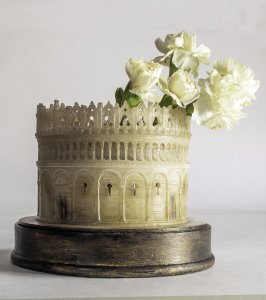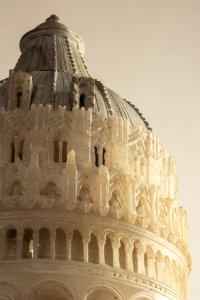Baptistry, Pisa
alabaster
10-1/2″ h., 1870’s
7500
Neither Roman, nor a ruin, the material of these Pisan architectural mementos –
alabaster quarried in nearby Volterra – was in use with models in Rome, Florence,
Pisa, and elsewhere by the third quarter of the 19th century. When we think of
Italian alabaster, what may come to mind is the soft, granular, bright white stone
from which souvenir knick-knacks were crudely carved into the 20th century. In
fact, the Volterran quarries, first set to use by the Etruscans twenty-five centuries
ago, offered a wide range of colored alabasters. One mid-19th century catalog lists 40 different types

These highly-detailed, intricately carved models of Pisa’s 14th century
Baptistry, are assembled from several different varieties of alabaster –a highly
translucent yellow veined stone; grey; and white. Often with alabaster pieces from
this period, souvenir sellers sought the rich patina of ancient Roman marbles,
though rendered in this far less costly material. Towards this, they devised an
unusual finish, “An artificial polish is given by the application with a woolen
cloth of a paste compounded of bone dust and common soap,” notes Stone
Magazine (1895).


